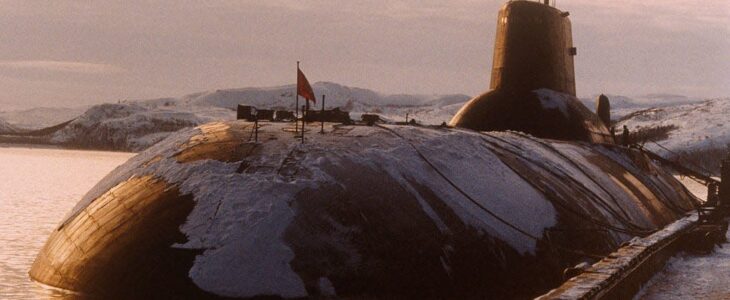
If you’ve ever seen The Hunt for Red October, you’re probably familiar with Russia’s truly massive Typhoon-class submarines. These Cold War giants still stand as the largest subs ever built.
Just how big are we talking? Each u-boat stretched to nearly 600 feet long and was wider than the average American house—and almost three times as tall, to boot.

In the 1970s, the Soviet Union embarked upon a new nuclear weapons program (code name: Typhoon) to develop a new missile-firing submarine and nuclear missiles. The subs (code name: Akula) were designed to be 566 feet long, 76 feet wide, and nearly 38 feet tall.
The Typhoon-class submarines displaced 23,200 tons in order to accommodate a payload of 20 RSM-52 ballistic missiles. Although most subs are relatively spartan in amenities, the transparent size of the Typhoons made it possible for engineers at St. Petersburg’s Rubin Design Bureau to squeeze in such unprecedented perks as a solarium, swimming pool, and sauna.

The first submarine in the Typhoon class, Dmitri Donskoy (TK-208), entered service in 1981. Russia built five Typhoons in total, but today, only Donskoy remains in service. The sub has spent its post-Cold War career as a test bed for a new generation of Russian submarine technologies and missiles, and was instrumental in testing the buggy Bulava submarine-launched ballistic missile.

Cutaway of a Typhoon-class submarine. Note that the submarine still retains torpedo tubes.H.I. Sutton/Covert Shores
The images directly above and below, which undersea warfare authority H.I. Sutton created, show the Typhoon in relation to the American Ohio-class ballistic missile submarines and the average American house. While the Typhoon-class subs are only 17 feet longer than the Ohio boats, they’re considerably wider and taller.

The Typhoon class compared to the Ohi0-class ballistic missile submarines and the average American house.H.I. Sutton/Covert Shores
A Typhoon sub looks so menacing because its sail (also known as the conning tower) is located behind the missile silos instead of in front of them, meaning the missiles are always included in any picture of the sub.
The titular Red October was supposed to be a fictional super-variant of the Typhoon class, equipped with six more RSM-52 missiles for a total of 52,000 kilotons of nuclear firepower. (The atomic bomb exploded at Hiroshima, by comparison, had a yield of 16 kilotons.)https://www.youtube.com/embed/unyjnpsualo?v=unyjnpsualo&start=0
Red October came packed with a magnetohydrodynamic drive (MHD) system, a real-life propulsion system that supposedly gave the ship a first-strike capability. In both The Hunt for Red October and the novel it was based on, the sub was designed to use its near-silent MHD propulsion to sneak to a position off the eastern seaboard of the U.S., launching its missiles in a surprise attack. This unadvertised capability was the final straw for ship captain Marko Ramius, who defects with his submarine to the U.S.
Today, a newer generation of Russian missile submarines, the Borei class, are replacing the Russian Navy’s aging Typhoon- and Delta-class subs. The Borei-class subs carry 16 Bulava missiles for a total explosive yield of 7,200 kilotons, though the Bulava missiles are likely much more accurate than their predecessors.

Dmitri Donksoi arriving at the Kronstadt Naval Base, St. Petersburg, July 2017.AFP Contributor – Getty Images
And since the Boreis are smaller and more space-efficient than their ancestors, they probably don’t have swimming pools. Russia plans to build at least eight Borei submarines, split between the Northern (Atlantic) and Pacific Fleets.
At 40 years old, Dmitri Donskoy is nearing retirement age. The Soviets built the Typhoon boats during a time before computers and compact ballistic missiles, and their size was dictated in large part by their enormous RSM-52 missiles. There may never be a class of submarines as big as the Typhoons… though never say never.
Credit: Yahoo News
